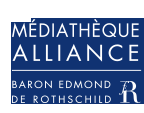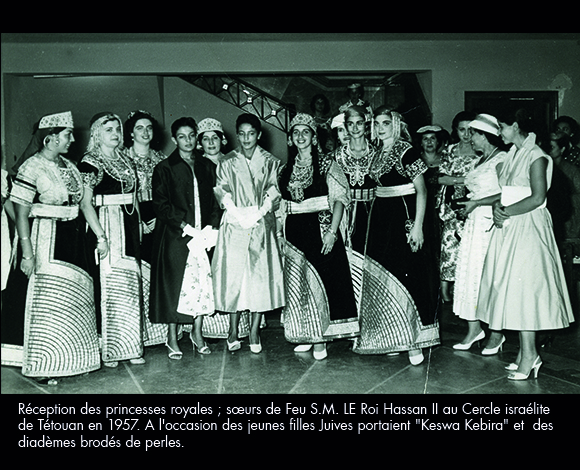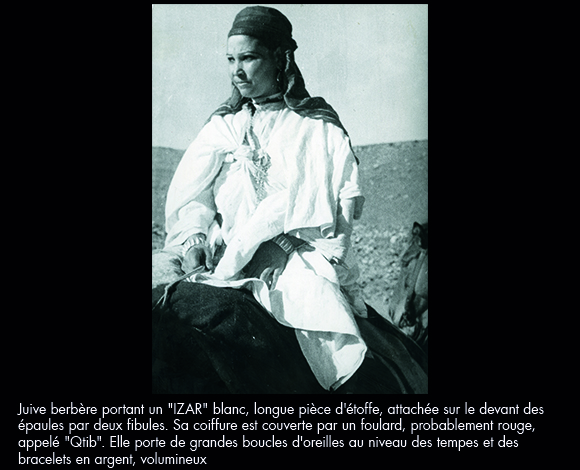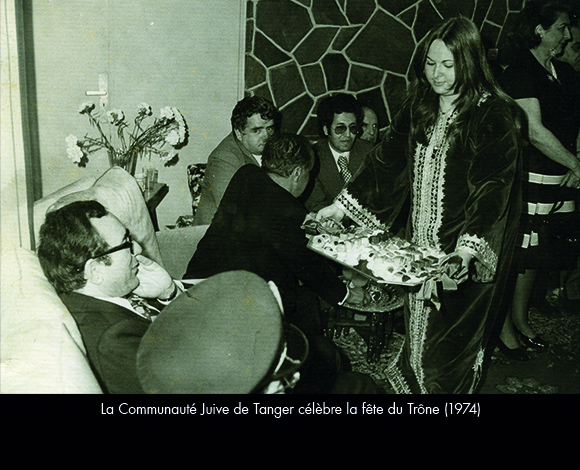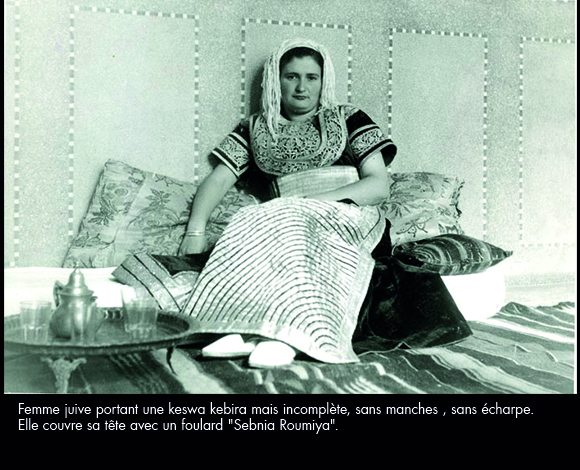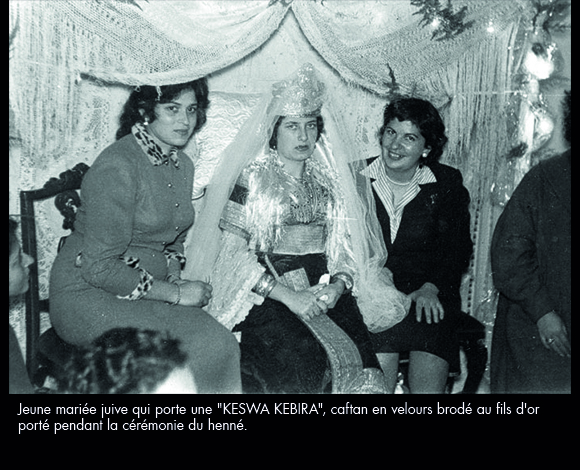The Jewish Costume of Morocco
According to Jean Besancenot, in his book Costumes du Maroc: “the Jewish population was integrated into Moroccan life in a multitude of ways, in all places and each with its own variations.”
In his descriptive and extensive study on the Jewish costumes of Morocco (1934-1939), Besancenot wrote: “in the cities, within the Jewish community, traditional clothing and European clothing coexist. The dress of women, in the mellah (Jewish quarters in Moroccan cities), essentially consists of the camisole (bata), the long gathered skirt, often with ruffles (saya) and the woolen shawl (pagnouelo).
Girls most often dress in European-made dresses, usually in bright colors.
The veil, for all, was made of a silk scarf, the same sebniya roumiya as that adopted by all urban Muslim women.
The tradition is preserved in the wedding costume, Keswa el kebira , caftan of the Jewish bride. It is worn by the bride and her parents during the wedding ceremonies. It is roughly the same in all cities of Morocco. The Keswa el kebira is entirely in velvet, generally green or blue for towns in the countryside and garnet red for towns on the coast and in the south."
This Jewish caftan "keswa el kebira" consists of several elements:
- A skirt, named zeltita (la tournante), a sort of wrap skirt that folds from left to right. It is decorated with numerous gold stripes.
- A broadly indented corselet, with short sleeves, the rombaïz, also overloaded with golden braids.
- Long and wide muslin sleeves, the kmam tchmira , are attached to the cuffs of the corselet.
- A large belt, hzam, of thick gold lamé folded in three goes around the waist several times.
A headdress often accompanies the keswa el kebira. It is a wig in the form of a soualef, made up of two fringes of false hair made of black silk threads, gathered in two plaits (dlalat) which fall on each side of the face in front of the shoulders.
It is the father of the bride who offered the keswa el kebira to his daughter, for her wedding. She then wears it throughout her life, on the occasion of major festivals: weddings, circumcisions, bar mitzvahs, etc.
Today, the keswa el kebira is still in use, worn by the Jewish bride during the henna ceremony.
According to Besancenot, it is interesting to note that Jewish women used to veil themselves, just like Muslims. “ Married women never come out without wrapped in their haik ” noted Dr. Lemprière during his trip in 1791.
The keswa el kebira was worn by the Jewish women of the mellahs of the big cities where a community of Andalusian Jews, the Sephardi, had settled in: Rabat, Salé, Tangier, Tétouan, Meknes, Fès, Marrakech, Essaouira, Safi and up to 'in Tiznit.
In the mellahs of the Anti-Atlas, in Talaïnt, Ifrane or Tahala, the Jews wore the Keswa el kebira, however this was not an exact replica of this costume.
The corselet and the plastron are the same: same cut, same abundance of golden braid, called qaftan. On the other hand, the skirt is of the same shape as the saya, cut in a rich material of velvet or silk; it is always called zeltita .
In general, the keswa el kebira festive costume was worn, according to Besancenot, in all the mellahs of the Anti-Atlas. Beyond there and further south, the Jews were draped in white cotton fabric just like the Muslim Berber women in these regions.
In the cities, the man's dress is first of all a shirt with a small straight collar, tshamir, kept in the serwal, wide and baggy pants, tight below the knee, the same as that of urban Muslims and rural Jews. Above the shirt, a long waistcoat, bediîyya , closed by a row of many small buttons. Finally, the Jewish city dweller wore a sort of long blouse, Zokha , open at the front and tight at the waist with a striped silk belt, kerziya . The Jewish city-dweller also wore the jellaba, the Muslim outer garment. The headdress consisted of a chachiya .
In the Berber regions , beyond the Anti-Atlas, and further south, the Berber Jewess dressed like the Muslim Berber. She did not wear sewn clothes, she draped herself in a long piece of fabric, the Izar - cotton wool or fine wool - held on the front of the shoulders by two fibulae, more or less tightened at the waist by a belt. A dress - shirt - could be used as underwear. The serwal, a type of loose trousers, were rarely worn. In general, the Izar is draped the same way in all Berber, Jewish or Muslim women. Sill, the headdress was specifically Jewish.
Religion forbids a Jewish woman to show her hair from the first day of her wedding, but the use of a wig is tolerated on condition that it does not contain human hair. To cover their hair, Berber Jews used wool, silk, goat hair, bovine tails and ostrich feathers. The headdresses were topped with scarves, diadems or silver ornaments.
In the Atlas and the villages of the south, the hayk was the garment of men. Its shape and dimensions resembled those of the Izar, the drape of Berber women. The fabric of the hayk was thick and locally woven from cotton threads and wool. The black chachiya was the headdress of all Berber Jews. After abandoning the traidional hayk, the Jews adopted the black jellaba, like the people in the cities. The black chachiya was held up by a blue or black headscarf with white polka dots.
In these southern regions, the Berber Jew wore the black burnous, called selham. He also wore the derra, a long white shirt with wide sleeves.
Bibliography:
Jean Besancenot, Costumes du Maroc , ed. La croisée des chemins / Edisud, Aix-en-Provence, Casablanca, 2000.
You can of course find all the documents from this exhibition on our digital library .


